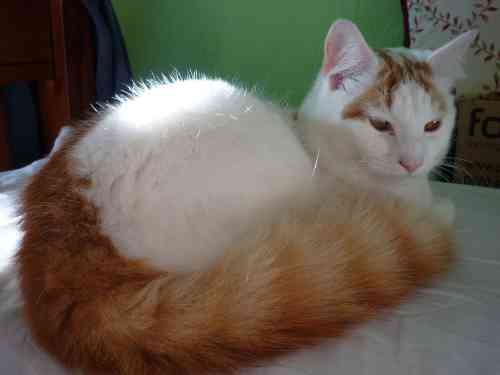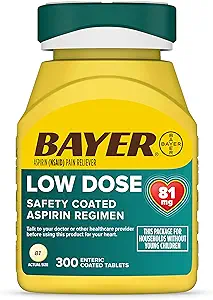A swollen tail in your cat
How to treat it yourself
A swollen tail in a cat can develop very suddenly. One moment there is nothing wrong and the next moment his tail is twice as thick. And we don’t mean that your cat raises its tail to let another cat or dog know what it thinks of it. No, we are talking about a swollen tail as a result of an accident or fight. So a medical problem. In this article we explain the difference between a swollen tail as a result of a bruise and as a result of an abscess. We will tell you more about the cause and what you can do yourself to treat it. So read on to find out how you can help your cat get rid of his swollen tail and his pain.
When does your cat have a swollen tail?
We often see a swollen tail on a cat when a cat is communicating with its body. A swollen puffy tail basically means your cat is excited. This could be angry excitement or excitement in a game with you or another cat.
But we don’t want to talk about that in this article. Here we discuss the medical problem if your cat has a swollen tail. So when there is something physically wrong with your cat’s tail.
What causes a swollen tail in your cat?
When damage has occurred to the tissues in your cat’s tail, many substances are released from the damaged cells. These substances enter the lymphatic vessels and blood vessels and then let the body “know” that a problem has arisen. The result is that the blood vessels open wide in that location. Much more blood will then flow to the damaged area in your cat’s tail. Those blood vessels also release more fluid and clearing cells from the bloodstream. This means that more fluid enters the damaged part of the tail. The consequence of more fluid is simply that the tail at the site of the damage thickens and swells.
However, it also often happens that a cat has a wound on its tail. Just very small, nothing special. For example, by a scratch from another cat. But if bacteria has ended up under the skin in that spot, many immune cells are sent to that spot. They have to clean up the bacteria. If this does not succeed quickly enough, the bacteria will multiply and immune cells will continue to be sent to it. In that case too, additional tissue damage is caused by the bacteria. So in that case too the blood vessels are opened and more fluid enters the area of the damage. Due to the accumulation of bacteria, immune cells (= pus cells), fluid and blood, your cat will also have a swollen tail in this case. We call this an abscess.
What other symptoms can you notice if your cat has a swollen tail?
In addition to a swollen tail in your cat, you may also notice the following symptoms in your cat:
- Pain when touching the tail
- Keep his tail lower than he used to
- The skin under the fur on the tail may look red or fiery
- Lots of licking or biting of his tail
- Plaintive meowing
- Less movement of his tail
- Exercise less in general
- Fever
- Poor appetite
- He may have problems with his balance. A study by Curt Walker has shown how important good tail mobility is in maintaining balance on narrow surfaces. This mobility is now less and so his balance is also less.
Diagnosis of a swollen tail in your cat
If you have discovered a swollen tail in your cat, in most cases it is a bruised tail or an infected tail. You probably know the latter better as an abscess on its tail. But how do you make the difference? Below we show you the characteristics that usually occur with the variant in question.
Bruised tail in your cat
- Painful to touch, but usually not extreme
- The swelling often feels a bit harder/stiffer than the normal tissue
- There is NO wound visible on the swelling
- In the center of the swelling there is also no piece of skin that looks different from that around it
- Your cat does NOT have a fever
- He has a normal appetite
Infection or abscess on your cat's tail
- The larger the abscess becomes, the more painful it becomes. Your cat may become very angry if you just lightly touch the swelling.
- The swelling feels a bit softer, especially after a day or 2. As if there is water under the skin.
- There is often a very small scratch or bite wound visible on the swelling
- When an abscess is 2 to 3 days old, an opening in the skin may begin to form.You can recognize this before it bursts open by a patch of skin of a few millimeters that looks a bit glassier and slightly grayer than the rest of the skin.
- Your cat may have a fever
- He has a bad appetite or none at all. He often eats only very tasty things or even nothing at all.
In most cases, an abscess will burst open about 3 days after the original wound appeared. At that moment, a hole has appeared in the skin through which the extremely smelly pus, often mixed with blood, comes out. It looks terribly dramatic, but your cat is suddenly in much less pain because the pressure is off. From then on it can start healing again.
Treating a swollen tail in your cat
A bruised tail
A bruise is caused by tissue damage. The treatment of a swollen tail as a result of a bruise is therefore aimed at repairing the tissue damage as quickly as possible. You can do this by holding warm compresses against his tail 3-4 times a day. The heat improves blood circulation in the tail and therefore sends more restorative substances and cells to the damaged tissues.
Applying an anti-inflammatory ointment is usually of no use in this case. The inflammation is much deeper in the tail and not just in the skin. An ointment will therefore hardly be able to penetrate into the depth of the tail and will therefore have no effect. In that case, it is better to use anti-inflammatory agents that you get into his entire body through his mouth. You can very well use CBD oil for this. From a study done by Cindy H.J. Yu and H.P. Vasantha Rupasinghe shows that CBD oil has a very good anti-inflammatory effect in cats and also has an analgesic effect. Very nice if your cat has a painful swollen tail.
Infection or abscess
If there is an abscess in your cat’s tail, it is wise to take your cat to your vet. In any case, he or she will prescribe antibiotics and a painkiller for your cat. If necessary, your vet may also open the abscess to remove the majority of the bacteria and pus. With the help of antibiotics, the bacteria left behind will no longer multiply and it can begin to heal.
However, cats are quite good at clearing abscesses on their own. Once it is bursted open and you massage out the newly formed pus several times a day, most cats will heal without giving a course of antibiotics. It’s just going to take about twice as long. After about 5 days, pus should no longer come out of the opening and the abscess will start to heal again. His tail should be completely healed after 14 days at the latest.
If your cat’s tail really hurts, you can give him a painkiller. It is best to give a painkiller given to you by your vet. But as an alternative, you can also give Aspirin to your cat. NB! ONLY ASPIRIN IS SUITABLE! SO DO NOT GIVE PARACETAMOL, IBUPROFEN OR OTHER HUMAN PAIN KILLERS TO YOUR CAT. THESE ARE DEADLY FOR YOUR CAT! You can give your cat half a tablet of a 81mg aspirin tablet once every 2 days (not twice a day!). These are tablets with a lower dosage than average. You may give this a maximum of one week.
How do you prevent a swollen tail in your cat?
You cannot easily prevent a swollen tail in your cat. After all, it probably occurs as a result of an accident or a fight. But by having your cat neutered you will ensure fewer fights and therefore fewer abscesses. You can also try to install more play equipment in your home so that your cat will go outside less often and will hopefully be less involved in an accident.
The story of Simba: a case study
Below you will find the story of Simba, a 4 year old female European Shorthair cat.
She was hit by a bicycle, which gave her a swollen tail. The neighbor saw the incident happen, so it is known what the cause was. Her owner has completely checked her over and can’t find any further problems. That’s why she decides to wait and see what happens at home for a few days.
The treatment plan for Simba is therefore aimed at supporting the healing of the bruised swollen tail. The following steps were performed:
- Heat compresses: Simba received heat compresses on the affected areas three times a day. This was done to improve blood circulation and reduce swelling. Each session lasted approximately 15 minutes and was applied with care to avoid burning or discomfort.
- CBD oil: In addition to the heat compresses, Simba was treated with CBD oil for animal use. The oil was added to some wet food twice a day to relieve pain and reduce inflammation. Close monitoring was done for any side effects (after all, all drugs can cause side effects), but Simba responded well to the treatment.
Results: After one week, Simba showed significant improvement. The swelling had reduced considerably, he was moving his tail more again and showed fewer signs of pain. The treatment with heat compresses and CBD oil were enough to help him recover.
Good luck!
Hopefully your cat’s recovery will be as smooth and problem-free as Simba’s. We wish your cat the best of luck and success in applying the treatment for you.







